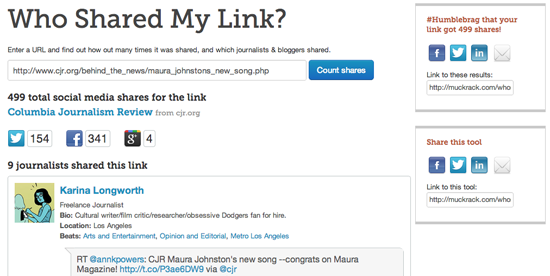After Muck Rack co-founder Gregory Galant wrote a guest column for Fortune last November, he wanted to see how it was being shared over social media and by whom. Fortune‘s site happens to have those little “shared by” counters on its articles, making it easier for Galant to track article shares, but many sites do not. In that case, Galant says, “I realized there’s no easy way to count shares short of making API calls … so we built a tool for it.”
That tool, Who Shared My Link? debuted this past weekend, accessible via Muckrack.com/whoshared or WhoSharedMyLink.com.
It’s simple to use: Enter a link in the prompt, and click to see how many times it was shared on Facebook, Twitter, Linkedin, Google+, and StumbleUpon. Link shorteners such as bit.ly are included in those counts, but whether or not shares from private or locked accounts count depends on the platform (on Facebook, they do. On Twitter, they don’t). And while it gives a pretty accurate count of how many times a link was shared, there’s no way yet to see who did the sharing unless it’s one of Muck Rack’s verified journalists:

Don’t know what I’m more impressed by: the 499 total shares, or the fact that four of them were on Google+
In addition to the nice ego boost that comes from seeing one’s work shared across social networks, Who Shared My Link? has practical uses as well.
“Journalism’s about informing people, so the number of people you inform and who they are is of course important,” Galant says, adding that the “shared by” metric is better than the pageview model. “It shows who cared enough about an article to share it with the friends and followers,” he says.
It also gives everyone — writers, editors, and readers alike — access to the same data. That’s not always true of pageviews, Galant explains: “Since pageviews are known only to the publishers, who usually embellish the numbers before releasing them, ‘shares’ is one of the few metrics that are public and equal across the Web.”
Of course, the number of shares is not always proportional to the quality of an article. “Like all metrics, I’d caution people about using the share count crudely without digging into why it’s being shared and how it’s spreading,” Galant says. “For example, Patch’s Animals Can’t Talk has 5,937 total social media shares as of right now, but if I were [AOL CEO] Tim Armstrong, I wouldn’t cite this article as an example of the future of journalism.”
If the number of shares are worth sharing, Who Shared My Link? also has a “#humblebrag” feature to tweet/Facebook/email etc. that information to the world. I pointed out to Galant that the autotext, which boasted about the total number of social media shares, read more like a plain old “brag” than a “#humblebrag,” and Muck Rack has since changed the wording to be more self-deprecating:

By the way: it was my best work. Along with everything else I’ve ever written.
The only problem now, as far as I can see, is that the #humblebrag sends out a link to the Who Shared My Link? page that lists your link’s shares. Which means there now exists a new link. Theoretically, that link could also be shared, and then Who Shared My Link? could be used to track how many people shared that link, and send out a tweet with a link to the page that shows how many people shared a link to a page that shows how many people shared a link, thus creating an infinite Klout feedback loop or an Influencer centipede.
Galant assures me that this terrifying prospect will not come to pass: “For the good of humanity, that’s not possible.”
Sara Morrison is a former assistant editor at CJR. Follow her on Twitter @saramorrison.
